Operation Examples When Using a Computer
When using the machine from a computer, you may need to configure the computer depending on the function. In addition, you may need the information of the computer to check the information to be set on the machine.
In this case, use the operation examples below to configure the settings and check the required information on the computer.
In this case, use the operation examples below to configure the settings and check the required information on the computer.
Creating a Shared Folder
When Using Windows
1
Create a folder in any location (such as Desktop).
2
Right-click the created folder, and click [Properties].
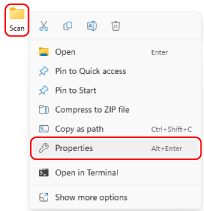
3
On the [Sharing] tab, click [Advanced Sharing].
The [Advanced Sharing] screen is displayed.
4
Select the [Share this folder] checkbox, and click [Permissions].
5
Configure the access permissions.

1
For [Group or user names], select [Everyone].
2
For [Permissions], select the [Allow] checkbox for [Change].
3
Click [OK].
6
Click [OK]  [Close].
[Close].
 [Close].
[Close].The created folder can be used as a shared folder.
NOTE
By registering the information of the created shared folder to the Address Book of the machine in advance, you can save the trouble of entering the information each time you send data. Registering Shared Folder Information to an Address Book
When Using macOS
1
Click [ ]
]  [System Settings]
[System Settings]  [General]
[General]  [Sharing].
[Sharing].
 [System Settings]
[System Settings]  [General]
[General]  [Sharing].
[Sharing].The [Sharing] screen is displayed.
2
Turn on [File Sharing], and click [ ].
].
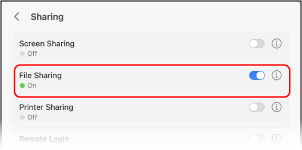
3
Under [Shared Folders], click [+].
4
Create a folder in any location (such as Desktop), and click [Add].

5
Configure the access permissions.
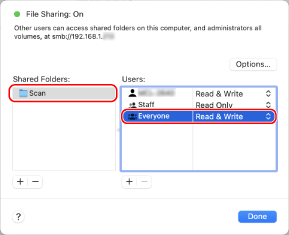
1
For [Shared Folders], select the created folder.
2
For [Users], select [Everyone]  [Read & Write].
[Read & Write].
 [Read & Write].
[Read & Write].6
Click [Done].
The created folder can be used as a shared folder.
NOTE
By registering the information of the created shared folder to the Address Book of the machine in advance, you can save the trouble of entering the information each time you send data. Registering Shared Folder Information to an Address Book
Enabling Network Discovery
1
Right-click [ ] (Start), and click [Network Connections].
] (Start), and click [Network Connections].
The [Network & Internet] screen is displayed.
2
Click [Advanced network settings]  [Advanced sharing settings].
[Advanced sharing settings].
 [Advanced sharing settings].
[Advanced sharing settings].The [Advanced sharing settings] screen is displayed.
3
Set [Network Discovery] to [On].
Displaying a Shared Printer in the Print Server
When Using Windows
1
Right-click [ ] (Start), and click [File Explorer].
] (Start), and click [File Explorer].
2
From [Network], select the print server to display the shared printer.
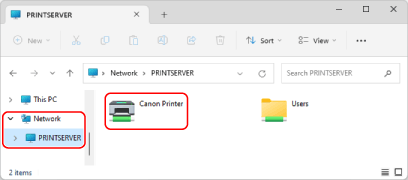
If nothing is displayed for [Network], enable network discovery. Enabling Network Discovery
When Using macOS
1
Click [ ]
]  [System Settings]
[System Settings]  [Printers & Scanners].
[Printers & Scanners].
 [System Settings]
[System Settings]  [Printers & Scanners].
[Printers & Scanners].The [Printers & Scanners] screen is displayed.
2
Click [Add Printer, Scanner, or Fax].
The [Add Printer] screen is displayed.
3
Click [ ] to display the shared printer.
] to display the shared printer.
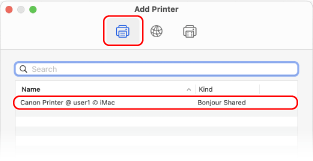
Checking the Login User Name for the Computer
When Using Windows
1
Click [ ] (Start)
] (Start)  [
[ ] (Settings)
] (Settings)  [Accounts].
[Accounts].
 [
[ [Accounts].
[Accounts].The [Accounts] screen is displayed.
2
Check the user name displayed on the right side of the icon image.
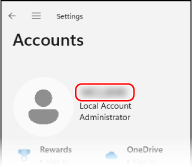
When Using macOS
1
On the Desktop, click [Go]  [Home].
[Home].
 [Home].
[Home].The home folder screen is displayed.
2
Check the user name displayed at the top of the screen.
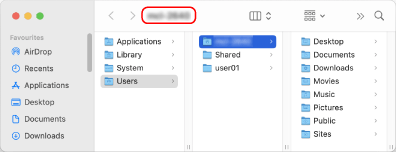
Checking the System Information of the Computer
When Using Windows
1
Right-click [ ] (Start), and click [System].
] (Start), and click [System].
The [About] screen is displayed.
2
Under [Device specifications], check the computer name and operating system version.
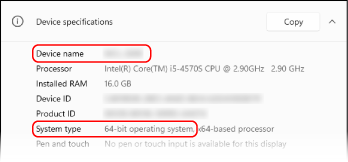
Check the computer name next to [Device name].
Check the processor version next to [System type].
For a 32-bit operating system, [32-bit Operating System] is displayed.
For a 64-bit operating system, [64-bit Operating System] is displayed.
When Using macOS
1
Click [ ]
]  [System Settings]
[System Settings]  [General]
[General]  [Sharing].
[Sharing].
 [System Settings]
[System Settings]  [General]
[General]  [Sharing].
[Sharing].The [Sharing] screen is displayed.
2
Check the computer name next to [Local Hostname].
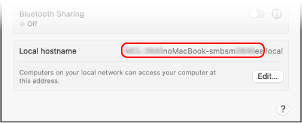
".local" at the end of the local host name is not included in the computer name.
Checking the Network Connection Information of the Computer
When Using Windows
1
Right-click [ ] (Start), and click [Network Connections].
] (Start), and click [Network Connections].
The [Network & Internet] screen is displayed.
2
Check the network connection information.
Checking the SSID (Network Name) of the Wireless LAN

Check the SSID under [Wi-Fi].
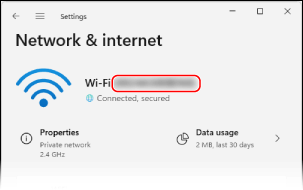
Checking the IP Address and DNS Server

1
Click [Properties] for the connected network.
2
Check the IP address and DNS server under [Properties].
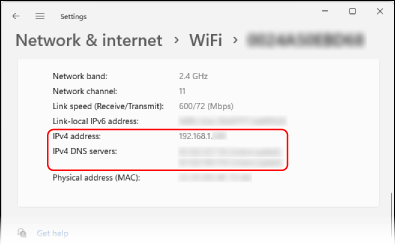
When Using macOS
1
Click [ ]
]  [System Settings]
[System Settings]  [Network].
[Network].
 [System Settings]
[System Settings]  [Network].
[Network].The [Network] screen is displayed.
2
Check the network connection information.
For Wired LAN

Click the network to view the details, and check the IP address and DNS server.
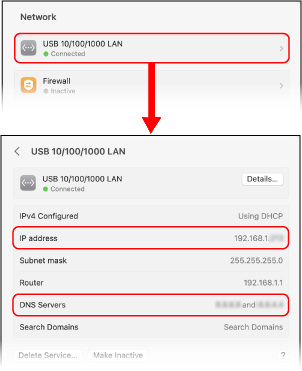
For Wireless LAN

1
Click [Wi-Fi].
The [Wi-Fi] screen is displayed.
2
Check the network connection information.
Checking the SSID (Network Name)
Check the SSID on the [Wi-Fi] screen.
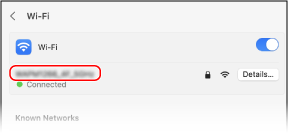
Checking the IP Address and DNS Server
Click [Details] and check the IP address on the screen displayed.
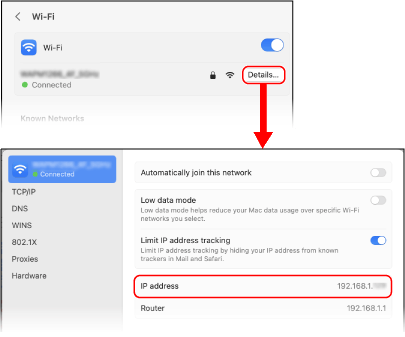
Click [Details]  [DNS], and check the DNS server on the screen displayed.
[DNS], and check the DNS server on the screen displayed.
 [DNS], and check the DNS server on the screen displayed.
[DNS], and check the DNS server on the screen displayed.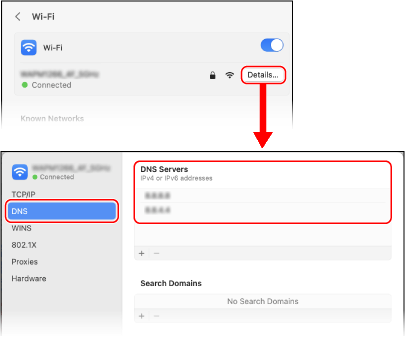
Checking the Printer Port
1
Click [ ] (Start)
] (Start)  [
[ ] (Settings)
] (Settings)  [Bluetooth & devices]
[Bluetooth & devices]  [Printers & scanners].
[Printers & scanners].
 [
[ [Bluetooth & devices]
[Bluetooth & devices]  [Printers & scanners].
[Printers & scanners].The [Printers & scanners] screen is displayed.
2
Click the printer driver of the machine  [Printer properties].
[Printer properties].
 [Printer properties].
[Printer properties].The printer driver properties screen is displayed.
3
On the [Ports] tab, check the port being used.
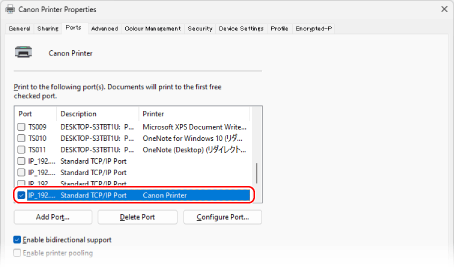
NOTE
If the IP address of the machine is changed after installing the printer driver, a new port needs to be added. Adding a Port
Checking Two-way Communication
1
Click [ ] (Start)
] (Start)  [
[ ] (Settings)
] (Settings)  [Bluetooth & devices]
[Bluetooth & devices]  [Printers & scanners].
[Printers & scanners].
 [
[ [Bluetooth & devices]
[Bluetooth & devices]  [Printers & scanners].
[Printers & scanners].The [Printers & scanners] screen is displayed.
2
Click the printer driver of the machine  [Printer properties].
[Printer properties].
 [Printer properties].
[Printer properties].The printer driver properties screen is displayed.
3
On the [Ports] tab, check that the [Enable bidirectional support] checkbox is selected.
Printing a Test Page
Required Preparations
Load A4 or LTR size paper in the paper drawer. Loading Paper in the Paper Drawer
When Using Windows
1
Click [ ] (Start)
] (Start)  [
[ ] (Settings)
] (Settings)  [Bluetooth & devices]
[Bluetooth & devices]  [Printers & scanners].
[Printers & scanners].
 [
[ [Bluetooth & devices]
[Bluetooth & devices]  [Printers & scanners].
[Printers & scanners].The [Printers & scanners] screen is displayed.
2
Click the printer driver of the machine  [Printer properties].
[Printer properties].
 [Printer properties].
[Printer properties].The printer driver properties screen is displayed.
3
On the [General] tab, click [Print Test Page].
When the print data is sent correctly, a test page is printed from the machine.
When Using macOS
1
Click [ ]
]  [System Settings]
[System Settings]  [Printers & Scanners].
[Printers & Scanners].
 [System Settings]
[System Settings]  [Printers & Scanners].
[Printers & Scanners].The [Printers & Scanners] screen is displayed.
2
Select the machine, and click [Printer Queue].
3
From the [Printer] menu, click [Print Test Page].
When the print data is sent correctly, a test page is printed from the machine.